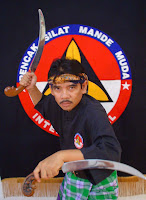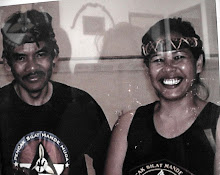The History of Pencak Silat Mande MudaPencak Silat Mande Muda is the Suwanda family martial art, which combines techniques and principles from 25 Pencak Silat styles from West Java and other areas of Indonesia . Although created by Guru Besar Uyuh Suwanda in 1951, it has its roots in very ancient and traditional styles of Silat. This art was promoted widely throughout the world by Guru Besar Herman Suwanda and continues to reach the masses with the help of Guru Besar Rita Suwanda.
The word "Mande" comes from "Cimande, which Pak Uyuh believed to be the original silat system of West Java, It is a powerful art, with most of the Indonesian men and women family of Cimande hiding from the public what they knew. Even if you were to ask them if they knew pencak silat, they would deny any knowledge of Cimande, or pencak silat in general.Being humble is a big part of being in good standing with the community and being a respectful person in pencak silat. We have no need to prove what we know, because what we know is part of our daily life. If you go to Cimande, you won't find people looking and talking like they know how to fight, but rather like everyday people working together to survive and live ordinary lives. They help one another in the village, sharing their knowledge with their family and neighbors.
"Muda" means "young" or "new". Mande Muda is likened to a young child always growing and looking for new silat material.The main principle of Mande Muda is to continuously develop and practice. Only death can stop your growth and study. Another principle is to wait, Pak Uyuh believed that by waiting, you can best answer the "question" posed by the attack. According to Pak Uyuh, if someone attacks you, give him the best "answer"-the best technique that will prevent him from attacking again.Right now PSMM ( Pencak Silat Mande Muda ) already grow up in Indonesia,USA and Europe. For more information about Pencak Silat Mande Muda international you can clik
http://www.suwandaacademy.com/ Guru Besar Uyuh Suwanda
Guru Besar Uyuh SuwandaPak Uyuh Suwanda was the founder of the Mande Muda self defense system, which he began in 1951 in Bandung, West Java, Indonesia. Like all traditional pencak silat, this was not open to the general public. Pak Uyuh had studied 17 styles of pencak silat. He added Cimande, when he married Mimi Rukmini who came from Cimande village, and many of her uncles and her father were freedom fighters against the colonization, before the independence and were from the Cimande family. Together they taught their combined system, which Pak Uyuh named "Mande Muda", to their family and friends.Pak Uyuh believed that each silat technique could be used differently in different situations and that there are no techniques which will work in all attacks. For this reason, he continuously studied pencak silat techniques and weapons to find the best answers to attacks, and ways to prevent attack. Pak Uyuh combined techniques from the 18 silat styles in an effective system which is unique and rich in knowledge.Pak Uyuh had a strong character and knew much about the traditional cultural beliefs of West Java. He planted in his children his love of the traditional ways and his determination to preserve them. Therefore, he always said to us that Mande Muda must not die. When the leader of the family system dies, then another must take his place. Pak Uyuh died in 1989, and Mande Muda is still alive because of the spirit and principles that he gave us.
Pak Herman was the second leader of Pencak Silat Mande Muda.He was first son in Suwanda Family. He began to study pencak silat from Pak Uyuh in 1960. In 1965, he began to also study with pendekars from other traditional pencak silat schools, and he continued to study until his death. He began teaching in Indonesia in 1974, and in 1980, he traveled to the US to begin teaching there. In addition to supervising the schools in Indonesia, he traveled extensively, teaching Pencak Silat Mande Muda seminars around the world. Pak Herman hoped to fulfill his father's dream of building a school for pencak silat students so that they would not have to practice outside or in the living room.Pak Herman worked to create our father's dream, as step by step, Mande Muda expanded around the world, first in America and then Europe. Besides teaching pencak silat, Pak Herman also taught about Indonesia's culture, especially the culture of Sunda (West Java).Due to his hard work, Pak Herman was successful in building a Padepokan (School), called the Padepokan Pencak Silat Suwanda Academy, located in Kampungdago, Suntenjaya, Lembang, West Java. His senior student, Steve Hunting, assisted him in making this project come true.The Suwanda Academy Padepokan has become the training center for members of Mande Muda both in Indonesia and worldwide. Each year, Pak Herman held "camps" in Indonesia so that his students from around the world could learn pencak silat and experience the culture of Java. Not only did he teach silat but also guided tours to historical places, including some in Central Java, plays, puppet shows, and other cultural events.Almost all plans and dreams can be created, but not only humans have a plan, and God's will determined that Pak Herman was to be killed in a car accident in Germany on the 21st of March 2000, just as Pak Herman was expanding Pencak Silat Mande Muda in Europe.Mande Muda has been guided by two generations, and both have succeeded in their mission to develop and expand the fighting arts and culture of Indonesia, particularly that of Pencak Silat Mande Muda.
 Guru Besar Rita Suwanda
Guru Besar Rita SuwandaShe is the third daughter of Pendekar Uyuh Suwanda. She grew up in a family of martial artists. Every day she saw her father training with his students. Her father was always kicking me out from training, because at that time, only men were allowed to practice pencak silat, because it is a hard art. She really like challenges and also loved pencak silat, so She always hid and learned by watching her father and practicing in secret. After he saw that she practiced seriously, her father finally let her practice pencak silat with him.When she was 14 years old, she began to compete in every competition sponsored by IPSI. She became a champion in Kembangan and Olahraga ( sport ) . She then became active in the IPSI organization. After her father died, and her brother moved to the US, she taught in her own school and also developed the Pencak Silat Mande Muda program in Indonesia. Besides learning pencak silat from her family, she also studied with other pendekars in IPSI. Her husband, Dadang Gunawan, is also one of her teachers, because he was one of her father's best students.After her brother, Pak Herman's, death, she was selected by her family and the Pencak Silat Mande Muda organization in Indonesia to be the third leader of Pencak Silat Mande Muda International.She thank Kathy Ohara who helped her with her first seminars in the US, and all of the students of her brother, and all those others who have helped her and promoted Mande Muda in Indonesia, US and Europe.
 Guru Besar Dadang Gunawan
Guru Besar Dadang GunawanPak Dadang is the husband of Ibu Rita Suwanda. From early childhood, Pak Dadang has had a rich and diverse education in Pencak Silat. At eight years old, he learned basic Pencak Silat from his father, training in Cikalong and Timbangan style. At 10 years old, he began to study Rikesan and Usik with Pendekars from Garut and Cianjur (West and East ends of West Java).Pak Dadang's training continued at the age of 12, with Pak Suherman. From this renowned instructor, Pak Dadang studied Maenpo (literally "forget to play"). Maenpo is an art that focuses strictly on self-defense and effective combat techniques. Pak Dadang has had significant training in other styles, including Cikalong, Usik, Rikesan, Timbangan, Benjang, Syahbandar, Sera, Liliwatan, Ulin Pa Macan, Limbuhan, Golok and other typical West Java weapon styles.In 1968, at the age of 17, Pak Dadang became a student of Pencak Silat Mande Muda. In addition to Mande Muda, he studied Cimande and other styles under Pak Uyuh Suwanda (the founder of PSMM). In 1969, Pak Dadang became a Pencak Silat champion, after competing in a tournament in West Java.He joined a delegation of competitors, following National championships all over Indonesia. He traveled throughout Indonesia, winning National level competitions in Surabaya and East Java.Pak Dadang began to play a more important role in the Pencak Silat Mande Muda organization. From 1970 until 1976, he worked together with Pak Uyuh, Pak Herman and other members of the organization to update the practice methods of Pencak Silat Mande Muda. As in other parts of the world, Indonesians were becoming more aware of the use of belt ranks in martial arts. Belt ranks made it easier to teach large groups of students. This modern principle was applied to Mande Muda in Indonesia and a curriculum was developed with five levels: (Sabuk Hitam, Hijau, Merah, Putih and Kuning (black belt, green, red, white, and finally progressing to yellow belt).In 1985, Pak Dadang traveled to the United States, along with Pak Uyuh and Pak Herman Suwanda. They performed demonstrations to promote Mande Muda and received a certificate of appreciation from the government of San Francisco.In 1990, Pak Dadang received the title of Deputy of Mande Muda Indonesia. In 2000, he became Guru Besar of Mande Muda Indonesia; a title that he shares with his wife, Ibu Rita Suwanda, who is Guru Besar of Mande Muda International.Pak Dadang's skill has made him well known in West Java and martial artists throughout Indonesia recognize him as a Pendekar (a title reserved only for the highest caliber of Silat Masters).
 Ibu Rita Suwanda and Pak Dadang are created a camp training in Indonesia on March,25 2009 until April,5 2009.One of student from US who joint to this camp ( Mr.Witthing ). He was trained in Ibu Rita's place,practiced 4 hour per day in 7 days. He teached by Ibu Rita and Pak Dadang. Beside that, they saw performance live of instrumental music traditional in Saung Angklung Mang Ujo, and
Ibu Rita Suwanda and Pak Dadang are created a camp training in Indonesia on March,25 2009 until April,5 2009.One of student from US who joint to this camp ( Mr.Witthing ). He was trained in Ibu Rita's place,practiced 4 hour per day in 7 days. He teached by Ibu Rita and Pak Dadang. Beside that, they saw performance live of instrumental music traditional in Saung Angklung Mang Ujo, and 


























